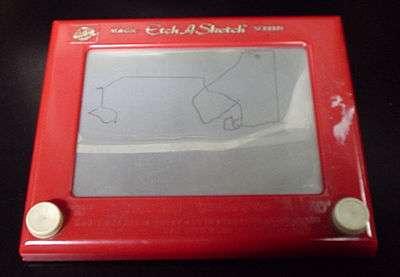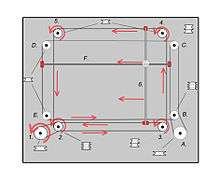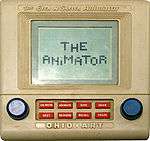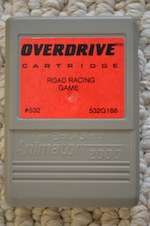Etch A Sketch
 | |
| Type | Drawing toy |
|---|---|
| Inventor | André Cassagnes |
| Company |
Ohio Art Company (1960-2016) Spin Master (2016–present) |
| Country | France, United States, Canada |
| Availability | 1960–present |
| Official website | |
Etch A Sketch is a mechanical drawing toy invented by André Cassagnes of France and subsequently manufactured by the Ohio Art Company[1] and now owned by Spin Master of Toronto, Canada.
An Etch A Sketch has a thick, flat gray screen in a red plastic frame. There are two knobs on the front of the frame in the lower corners. Twisting the knobs moves a stylus that displaces aluminum powder on the back of the screen, leaving a solid line. The knobs create lineographic images. The left control moves the stylus horizontally, and the right one moves it vertically.
The Etch A Sketch was introduced near the peak of the Baby Boom on July 12, 1960 for $2.99.[2] It went on to sell 600,000 units[2] that year and is one of the best known toys of that era. In 1998, it was inducted into the National Toy Hall of Fame at The Strong, in Rochester, New York. In 2003, the Toy Industry Association named Etch A Sketch to its Century of Toys List, a roll call commemorating the 100 most memorable and most creative toys of the 20th century.[3]
Mechanics

The toy is a kind of plotter. The inside surface of the glass screen is coated with aluminium powder, which is then scraped off by a movable stylus, leaving a dark line on the light gray screen. The stylus is controlled by the two large knobs, one of which moves it vertically and the other horizontally. Turning both knobs simultaneously makes diagonal lines. To erase the picture, the user turns the toy upside down and shakes it. Doing this causes polystyrene beads to smooth out and re-coat the inside surface of the screen with aluminum powder. The "black" line merely exposes the darkness inside the toy. Filling in large "black" areas allows enough light through to expose parts of the interior.
History
The Etch A Sketch toy was invented in the late 1950s by André Cassagnes,[4][5][6] an electrician with Lincrusta Co, who named the toy L'Ecran Magique (The Magic Screen).[2] In 1959, he took his drawing toy to the International Toy Fair in Nuremberg, Germany. The Ohio Art Company saw it but had no interest in the toy. When Ohio Art saw the toy a second time, they decided to take a chance on the product. L'Ecran Magique was soon renamed the Etch A Sketch and became the most popular drawing toy in the business. After a complex series of negotiations, The Ohio Art Company launched the toy in the United States in time for the 1960 Christmas season with the name "Etch A Sketch". Ohio Art supported the toy with a televised advertising campaign.[7]
Etch A Sketch was manufactured in Bryan, Ohio until the company moved the manufacturing plant to Shenzhen, China in 2001.[8]
In France, its country of origin, Etch A Sketch was sold under the name of "Télécran",[9] rather than L'Ecran Magique.
In February 2016 the rights to the Etch A Sketch name and design were acquired by Toronto-based Spin Master Corporation.[10]
Etch A Sketch Animator

The Etch A Sketch Animator (known simply as "The Animator" in Europe), debuted in 1986,[7] and featured a low-resolution dot matrix display and used two knobs for drawing, like a regular Etch A Sketch, with several buttons to manipulate the drawings. It had a few kilobytes of memory, capable of storing 12 frames of pictures in any combination up to 96 times. It contained a speaker, which made static-like sounds when the knobs were moved and during animations.
Etch A Sketch Animator 2000


In 1988, Ohio Art introduced a more advanced version of the Etch A Sketch Animator known as the Etch A Sketch Animator 2000. The initial price was $139.99. It featured a low-resolution LCD screen. It also featured 196 kilobytes of "powerful computer memory". The Etch A Sketch Animator 2000 replaced the well known knobs with "The Magic Touchpad". The Etch A Sketch Animator 2000 also had a cartridge slot for additional memory or game cartridges. Four cartridges were made for the Etch A Sketch Animator 2000: "Fly By"', a flight simulator game, "Overdrive", a road racing game, "Putt-Nuts", a miniature golf game, and "Memory", a memory expansion cartridge.The price for one cartridge was $28.99. The Etch A Sketch Animator 2000 can do 22 frames of pictures and 99 frames of animation.
Etch A Sketch Color
In 1993, Ohio launched a Color Etch A Sketch.[7] Similar to the original Etch A Sketch, it used the traditional two-knob interface to draw, but also featured six colors. It also had the ability to produce a color copy of each picture drawn
Etch A Sketch ETO - Plug and Play Drawing System / Etch A Sketch Wired
These are basically hand-held controllers that connect to a television like handheld TV games and work like a regular Etch A Sketch, except on the television screen and with the addition of colors and sound effects.
Etch A Sketch art
There are a few practicing artists who use the Etch A Sketch to produce professional lineographic work. Most artists make their work permanent by removing the aluminum powder. This is done either by drilling holes in the bottom of the toy or by removing the entire plastic backing. It is then resealed as a semi-permanent, shake-resistant piece of art.
See also
- Magna Doodle, a somewhat similar toy using a different principle of operation.
- "The Mystic Writing Pad" (also called Wunderblock), an old children's toy, which can be used for writing or drawing, consisting of a thin sheet of clear plastic covering a thick waxed board.
- Etch-a-sketch gaffe during the 2012 Mitt Romney presidential campaign.
- There is an Etch-a-Sketch in the movie Toy Story, and its sequels Toy Story 2 and Toy Story 3.
References
- ↑ "Etch A Sketch Creator Dies". Gifts & Decorative Accessories Magazine. 2013-01-31. Retrieved 2013-02-02.
- 1 2 3 Coopee, Todd. "Etch A Sketch". ToyTales.ca.
- ↑ "Toy Industry Association Announces Its Century of Toys List". Business Wire. January 21, 2003. Retrieved October 31, 2008.
- ↑ http://www.giftsanddec.com/article/559614-Etch_A_Sketch_Creator_Dies.php
- ↑ Nelson, Valerie J. (2 February 2013). "Andre Cassagnes dies at 86; Etch A Sketch inventor". Los Angeles Times.
- ↑ http://www.toyassociation.org/PressRoom2/News/2013_News/Andr__Cassagnes__creator_of_Etch_A_Sketch__Dies_at_the_Age_of_86_.aspx#.Uny4QvmURqW
- 1 2 3 "Ohio Art Has History". 2015. Archived from the original on 2015-07-13.
- ↑ Joseph Kahn (7 December 2003). "AN Ohio Town Is Hard Hit as Leading Industry Moves to China". The New York Times. (Also found at PracticalMachineist.com, archived at Archived 4 April 2016 at the Wayback Machine. as of April 4, 2016)
- ↑ "TV ad on french TV" Institut national de l'audiovisuel, 2 December 1979.
- ↑ "U.S. company sells Etch A Sketch to Toronto toy firm". The Canadian Press. February 12, 2016. Archived from the original on 2016-02-12.
External links
| Wikimedia Commons has media related to Etch A Sketch. |
- Official Ohio Art Company Etch A Sketch website
- "How does an Etch A Sketch work?". How Stuff Works.
- Video looking at the chemistry of the Etch-a-Sketch powder inside
- U.S. Patent 3,055,113